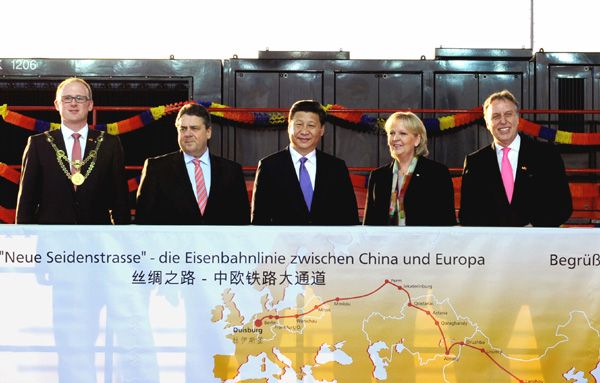Europe's energetic bottom-up response to Belt and Road
By FU JING (China Daily) Updated: 2016-05-04 08:23
 |
|
Chinese President Xi Jinping (center) visits Port of Duisburg of Germany March 29, 2014. [Photo/Xinhua] |
In recent weeks, China's Belt and Road Initiative, the Silk Road Economic Belt and 21st Century Maritime Silk Road, has got several bottom-up but energetic responses from Europe. Among them was the formation of the Europe and China tourism and cultural development committee a few days ago in Brussels. The committee is the brainchild of Benard Dewit, chairman of the Belgian-Chinese Chamber of Commerce and other key European brains.
The rational behind the formation of the committee is to better serve Chinese tourists whose steadily rising numbers have become a key driver of Europe's tourism sector and and its infrastructure development.
Before the committee was formed, China EU, a Brussels-based non-profit organization, whose aim is to promote EU-China exchanges in the internet and telecommunications sectors, had organized a panel discussion in London on how to insert digital content into the Belt and Road Initiative and develop a "Digital Silk Road".
In March, France-based Neoma Business School had organized a forum in Paris to discuss how to make the best use of Europe's green technology and knowhow and China's capital and manufacturing capacities, in order to ensure the Belt and Road Initiative adopts a greener and sustainable approach.
And before the Paris forum, Jan Kohout, an adviser to Czech President Milos Zeman on Chinese affairs, set up the first think tank in Europe that would focus on Belt and Road Initiative research.
These four developments in Europe come nearly three years after President Xi Jinping announced the initiative in 2013 to better connect Asia, Europe and Africa. Since then, up to 20 governments in Europe have echoed China's proposals and even the European Union, as a whole, is working with China to launch joint funds to help synergize the Belt and Road Initiative and European investment schemes.

I’ve lived in China for quite a considerable time including my graduate school years, travelled and worked in a few cities and still choose my destination taking into consideration the density of smog or PM2.5 particulate matter in the region.











